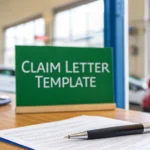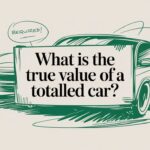Wondering how much does an accident devalue a car? While there’s no single formula, most vehicles lose between 10% and 30% of their pre-accident value—even after perfect repairs. In this guide, we’ll explain what determines how much your car’s value drops after a collision and what you can do to claim compensation for that loss.
The Real Cost of a Car Accident
When you get into a wreck, your first thought is usually about getting it fixed and back on the road. But the financial pain doesn’t end when you leave the body shop. Even with flawless repairs, your car now has an accident on its record—a permanent blemish that drags down its market value.
This hidden financial hit is what we call diminished value. Think of it as the automatic discount a future buyer will demand just because your car was in a collision. They’ll almost always choose a car with a clean history over one that’s been damaged and repaired, no matter how good the work looks.
An accident creates a permanent and often significant drop in your car’s resale price. Even with perfect repairs, a vehicle’s market value can easily fall by 20%, and in some cases, the loss can climb as high as 50%. Why? Because savvy buyers know how to spot signs of previous damage, and the vehicle history report will spell it out in black and white. For more on this, the International Risk Management Institute offers some great insights into how this works.
Key Factors That Influence Your Car’s Value Loss
Several key things determine exactly how much value your car loses after a wreck. It’s not a simple, one-size-fits-all formula; every situation is different. Understanding these factors is the first step toward building a solid case for the compensation you’re owed.
Here’s a quick breakdown of the main variables that determine how much value your car loses after a collision.
| Factor | Impact on Value | Example |
|---|---|---|
| Severity of the Damage | High | A minor fender-bender has a much smaller impact than a major collision involving frame damage. Structural repairs are a huge red flag for buyers. |
| Age and Mileage | High | Newer cars with low mileage suffer the biggest percentage loss. Buyers expect these vehicles to be perfect, so an accident history causes a steep drop. |
| Make and Model | Medium | Luxury, exotic, and high-demand vehicles often see a larger drop in value. The market for these cars is more sensitive to imperfections. |
| Quality of Repairs | Medium | Using original manufacturer (OEM) parts and a certified shop helps, but it won’t erase the loss. Bad repairs will make the problem much worse. |
Ultimately, this loss is something you are entitled to recover from the at-fault party’s insurance. But here’s the catch: insurance companies aren’t just going to hand it over. You have to prove your loss with credible evidence, and that’s where a SnapClaim report becomes your most powerful tool.
Understanding Diminished Value

To really wrap your head around how much an accident devalues a car, you have to start with the core concept: diminished value. Think of it as the permanent financial scar your car carries long after the physical damage has been perfectly repaired.
Let’s paint a picture. Imagine two identical used cars side-by-side on a lot—same make, model, year, and mileage. One has a squeaky-clean vehicle history report. The other was in a serious collision but was restored so well it looks brand new.
Which one are you buying? If you’re like most people, you’ll pick the one with no accident history. Or, at the very least, you’d demand a steep discount on the one that was wrecked.
That discount? That’s diminished value in a nutshell. It’s the very real cash value your car has lost simply because it now has a permanent black mark on its record.
The Three Types of Diminished Value
While the idea is simple, diminished value actually breaks down into three distinct categories. Knowing the difference is key to understanding what you can—and should—be claiming from the at-fault driver’s insurance company.
- Immediate Diminished Value: This is the value drop that happens the second the accident occurs, before any repairs are made. It’s the difference between your car’s value pre-crash and its value while damaged.
- Repair-Related Diminished Value: This loss stems from shoddy repair work. Think mismatched paint, cheap aftermarket parts instead of OEM, or sloppy frame alignment. Poor quality repairs will sink your car’s value even further.
- Inherent Diminished Value: This is the big one and the basis for nearly every claim. It’s the unavoidable loss in value that remains even after a top-tier body shop does a flawless repair using the best parts available.
For almost every claim, you’ll be going after inherent diminished value. This is the loss you are legally owed by the at-fault party’s insurance.
Why Inherent Diminished Value Matters Most
Inherent diminished value is the heart of the matter because it’s a loss that even the best body shop in the world can’t fix. Thanks to vehicle history reports from services like CARFAX and AutoCheck, that accident history is out there for any potential buyer to see.
When a shopper pulls up that report and sees “Accident Reported,” their mindset instantly changes. They start worrying about hidden structural damage, future reliability issues, or whether the car is as safe as it once was. This perception alone forces you to slash your asking price to even have a chance of competing with similar cars that have a clean record.
This isn’t just some theoretical loss; it’s a real financial hit you will take the day you try to sell or trade in your car. The at-fault driver’s insurance is responsible for making you “whole,” and that includes compensating you for this proven, permanent loss of market value. To get a better handle on this, check out our deep dive into what a diminished value claim is and how the process works.
But getting the compensation you deserve isn’t as simple as just asking for it. You need to come with undeniable proof. This is where an independent, certified appraisal report from SnapClaim becomes your most powerful tool, turning your claim from a simple opinion into a fact-based demand that insurers have to take seriously.
How Insurance Companies Undervalue Your Claim

When you file a diminished value claim, you’d think the at-fault driver’s insurance company would assess the loss fairly and cut you a check. Unfortunately, that’s almost never how it goes.
Insurance adjusters are not on your side. Their job is to protect their company’s profits by minimizing payouts. From the moment you file, you’re in a negotiation where their goal is to close your claim for the smallest amount possible.
This creates a massive conflict of interest. Their first offer is rarely their best—it’s a lowball number they throw out to see if you’ll just take it and walk away.
The Problem with Standardized Formulas
To make their low offers seem legitimate, many insurance companies lean on a flawed, one-size-fits-all calculation called the “17c Rule.” This formula came out of a single court case in Georgia and was never meant to be a national standard for calculating diminished value.
But insurers absolutely love it. Why? Because it’s designed to produce consistently low numbers that save them a fortune.
Here’s a quick look at how it works to whittle down your claim:
- Start with a Cap: First, it caps the maximum possible loss at just 10% of your car’s pre-accident value (using a guide like NADA).
- Apply a Damage Modifier: Then, it multiplies that number by a subjective “damage modifier” ranging from 0.00 (no structural damage) to 1.00 (severe structural damage).
- Apply a Mileage Modifier: Finally, it multiplies that result by another modifier based on mileage, shrinking the payout even further.
This rigid process spits out a number that’s often a tiny fraction of your car’s true loss in value. It completely ignores what real buyers in your area are willing to pay, the demand for your specific make and model, and the unique details of your accident.
Why Their Valuation Tools Are Flawed
It’s not just the 17c Rule. The internal software and valuation tools adjusters use are also programmed with data and assumptions that benefit the insurer. They simply don’t reflect what an actual buyer in your local market would pay for a car with an accident on its record.
Think about it this way: while normal vehicle depreciation averages around 12.5% a year, an accident triggers a much steeper, immediate drop. This is especially true today. Even as the inflated used car values from the pandemic era come down, buyers are still paying a premium for cars with a clean history. You can learn more about how depreciation trends impact vehicle value on U.S News. An insurer’s in-house calculator just isn’t built to capture that real-world buyer psychology.
This is exactly why you can’t trust the at-fault driver’s insurance company to give you a fair number. Their methods are intentionally subjective and confusing, giving them the advantage in any negotiation. To fight back, you need objective, independent proof of your loss.
Knowing the game is rigged is the first step. The next is learning how to file a diminished value claim with the right evidence to back it up. A certified appraisal report from a neutral expert like SnapClaim replaces their biased opinion with hard data, leveling the playing field. It forces them to negotiate in good faith.
And with our money-back guarantee—if our report doesn’t help you recover at least $1,000, you get a full refund—there’s zero risk in arming yourself with the proof you need.
Proving Your Loss with a Certified Appraisal
So, you’re trying to figure out how much an accident devalues a car, and the insurance company’s first offer feels… low. Their valuation is just their opinion, one that’s shaped by formulas designed to protect their bottom line.
How do you fight back against a lowball number? Simple. You counter their opinion with cold, hard facts.
A certified diminished value appraisal is the single most powerful piece of evidence you can bring to the table. This isn’t just a number pulled from an online calculator; it’s a detailed, comprehensive report put together by an independent expert who knows the market inside and out.
An appraiser digs into your specific car—its condition, the severity of the damage, the quality of the repairs, and what similar cars are actually selling for in your area. This completely changes the conversation. It’s no longer your word against theirs. It’s a data-driven negotiation where you’re holding all the proof.
What Makes a Certified Appraisal So Powerful
A professional appraisal report is your best weapon for getting a fair settlement. Unlike the insurance company’s internal math, a certified report is built on transparency and objective market analysis. It delivers the specific, documented evidence needed to support your claim.
A credible SnapClaim report will always include:
- Pre-Accident Fair Market Value: A detailed breakdown of what your vehicle was worth the moment before the collision.
- Post-Repair Fair Market Value: An honest assessment of your vehicle’s worth after repairs, accounting for the permanent stigma of an accident history.
- Comparable Vehicle Analysis: A look at similar cars for sale in your local market, highlighting the price drop between vehicles with clean histories and those with accident records.
- Supporting Documentation: All the backup evidence, like the repair estimate, damage photos, and relevant market data that validates the final number.
This level of detail takes your claim from a simple request and turns it into a formal demand backed by an expert. You can learn more about what a car appraisal after an accident covers and why it’s so critical for your claim.
Building an Evidence-Based Case
The foundation of any strong diminished value claim is a rock-solid evaluation of your vehicle’s condition. A critical part of any appraisal is a detailed assessment of the vehicle’s state. If you want to understand more about how experts evaluate vehicles, this guide on Understanding Auto Condition Reports from ShipCargo is a helpful resource. It gives you a good sense of the meticulous process involved.
An independent appraisal report from SnapClaim provides exactly that level of detailed analysis, creating a clear, evidence-based argument that insurance adjusters can’t just brush aside. It shows them you’ve done your homework, you know your rights, and you have the documents to prove your valuation. This professional approach gives you serious leverage during negotiations.
At the end of the day, you are entitled to be made whole after an accident that wasn’t your fault. That includes fair compensation for the permanent hit your vehicle’s market value has taken. Don’t just accept the insurer’s lowball offer. Arm yourself with a certified report and demand every dollar you’re rightfully owed.
Your Step-by-Step Guide to a Diminished Value Claim
Knowing your rights is one thing, but actually getting the insurance company to pay up is another. Filing a diminished value claim can feel like a maze, but if you follow a clear roadmap, you can confidently chase down the compensation you’re owed. This guide is your playbook for building a solid, evidence-based case.
Following a proven process does more than just keep you organized. It shifts you from being a victim of circumstance to a prepared advocate for your own financial interests.
Step 1: Confirm Your Eligibility and Gather Documents
First thing’s first: make sure you can actually file a claim. In nearly all situations, you can only file a diminished value claim against the at-fault driver’s insurance company. You typically can’t file against your own policy unless you live in one of the very few states that allow it.
Once you’ve confirmed you’re good to go, it’s time to gather your evidence. The more paperwork you have, the stronger your argument will be.
- The Police Report: This is your official proof of who caused the accident.
- Repair Invoices: Get the final, itemized bill from the body shop. This document details every part replaced and every hour of labor, proving the extent of the damage.
- Photos: You’ll want pictures of the damage before the repairs and photos of the finished work.
- Vehicle Title and Registration: Simple proof that you own the car.
This stack of paperwork is the foundation of your entire claim.
Step 2: Get a Certified Appraisal
This is, without a doubt, the most important step. Don’t ever rely on the insurance company to tell you what your car’s value has dropped by. You need an independent, expert opinion to counter their inevitable lowball offer.
A certified appraisal from a trusted provider like SnapClaim arms you with objective, data-driven proof. It calculates your car’s specific loss in value based on real market data, the quality of the repairs, and its new accident history. This turns your claim from a simple request into a fact-based demand.

This appraisal gives you a clear, defensible number that becomes the cornerstone of your demand letter. You can also use a diminished value claim calculator to get a quick ballpark estimate of your potential loss before you commit.
Step 3: Submit a Formal Demand Letter
With your appraisal report in hand, it’s time to make it official. You’ll send a formal demand letter directly to the at-fault driver’s insurance adjuster. Keep the letter professional, direct, and to the point.
Make sure it includes:
- The date and location of the accident.
- The insurance claim number.
- A clear statement that you are seeking compensation for your vehicle’s inherent diminished value.
- A copy of your certified appraisal report as the primary piece of evidence.
This letter officially kicks off the negotiation process and signals to the insurer that you’re serious and have the expert documentation to back it up.
Step 4: Negotiate Professionally
The adjuster’s first move will almost certainly be a counteroffer that’s much lower than your demand. Don’t get discouraged—this is part of the game.
Your job is to respond calmly and professionally, pointing back to the facts in your appraisal report. Remind them that the report is based on market data, not your opinion. Stick to your evidence and avoid getting emotional. The vast majority of these claims are settled through this professional back-and-forth.
An accident slams the gas pedal on a car’s natural depreciation. For instance, New Zealand experiences the highest vehicle depreciation in the world, where cars lose about 54% of their value after just 56,000 km. Cars in Australia lose about 45% over the same distance, while the average across OECD countries is around 31%. An accident stacks a sudden, steep loss right on top of those trends. In some complex cases, bringing in an attorney is a smart move.
FAQ: Car Devaluation After an Accident

When you’re trying to figure out how much an accident devalues a car, a lot of questions pop up. It’s easy to feel overwhelmed by the process. Here are straightforward answers to some of the most common questions we hear from vehicle owners.
Can I file a diminished value claim if the accident was my fault?
This is a big one, and the short answer is almost always no. Diminished value claims are designed to be filed against the at-fault driver’s insurance policy. It’s how you hold the liable party responsible for the full financial damage they caused—which includes the permanent hit to your car’s market value. Your own collision coverage is there to handle the physical repairs, not to compensate you for lost resale value.
How long do I have to file a diminished value claim?
Every state has a legal deadline for filing property damage claims, called the statute of limitations. This time limit is non-negotiable—if you miss it, you lose your right to pursue compensation for good. This window usually ranges from two to six years from the date of the accident, depending on where you live. However, we strongly recommend starting the claim process the moment your vehicle repairs are finished to build the strongest case. For official info on state-specific rules, the National Highway Traffic safety Administration (NHTSA) is a solid government resource.
What if the insurer denies my claim or makes a low offer?
Don’t panic. An initial denial or a laughably low offer is a standard tactic. It’s the insurance adjuster’s opening move, designed to see if you’ll get discouraged and just walk away. Your best response is to counter their opinion with cold, hard facts. This is where a certified, independent appraisal report becomes your most powerful weapon, as it rejects their biased math and shows you have evidence to support your claim.
Does my car’s age and mileage impact the claim amount?
Absolutely. A vehicle’s age, mileage, and overall condition are some of the most important factors that determine how much an accident devalues a car. A newer vehicle with low mileage is going to take a much bigger financial hit—in both percentage and dollar terms—than an older car with a lot of miles on it. A buyer shopping for a newer, low-mileage car places a huge premium on a clean history, so an accident on the record causes a steep and immediate drop in what they’re willing to pay.
About SnapClaim
SnapClaim is a premier provider of expert diminished value and total loss appraisals. Our mission is to equip vehicle owners with clear, data-driven evidence to recover the full financial loss after an accident. Using advanced market analysis and industry expertise, we deliver accurate, defensible reports that help you negotiate confidently with insurance companies.
With a strong commitment to transparency and customer success, SnapClaim streamlines the claim process so you receive the compensation you rightfully deserve. Thousands of reports have been delivered to vehicle owners and law firms nationwide, with an average of $6,000+ in additional recovery per claim.
Why Trust This Guide
This article was reviewed by SnapClaim’s team of certified auto appraisers and claim specialists with years of experience preparing court-ready reports for attorneys and accident victims. Our content is regularly updated to reflect the latest industry practices and insurer guidelines.
Get Started Today
Ready to prove your claim? Generate a free diminished value estimate in minutes and see how much you may be owed.
Get your free estimate today





